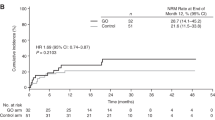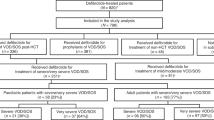Abstract
Survival for high-risk neuroblastoma patients is still suboptimal. Although stem cell transplantation (SCT) is used, there is no consensus as to which conditioning regimen has the greatest efficacy and fewest toxicities. We assessed the incidence of and risk for hepatic veno-occlusive disease (VOD) for neuroblastoma patients who underwent autologous SCT with busulfan and melphalan (BuMel) at eight centers following Children’s Oncology Group (COG)-based induction chemotherapy. Data regarding the patients, SCT characteristics, busulfan steady-state concentrations, incidence of VOD, and survival were evaluated. VOD was defined using the modified Seattle criteria. Possible factors associated with VOD (age, busulfan-pharmacokinetic parameters, history of hepatic dysfunction, and day of neutrophil engraftment) were evaluated. Seventy five patients were included and 23 children (31%) developed VOD at a median of 19 days after SCT (range 14–27 days). VOD was the cause of death in 4 patients (5%). In a multivariable analysis, young age (OR 1.7 (95% CI: 1.16–2.56; p = 0.012)) and early day of neutrophil engraftment (OR 1.4 (95% CI: 1.08–2.14; p = 0.041) were associated with the development of VOD. Initial or cumulative busulfan steady-state concentration were not associated with VOD. We found that despite the use of intravenous busulfan with adjusted serum levels, the incidence of VOD remains high in pediatric neuroblastoma patients.
This is a preview of subscription content, access via your institution
Access options
Subscribe to this journal
Receive 12 print issues and online access
$259.00 per year
only $21.58 per issue
Buy this article
- Purchase on Springer Link
- Instant access to full article PDF
Prices may be subject to local taxes which are calculated during checkout
Similar content being viewed by others
References
Bleyer A, OLM Barr R, Ries LAG. Cancer epidemiology in older adolescents and young adults 15 to 29 years of age, including SEER incidence and survival: 1975-2000. NIH Pub. No. 06-5767. Bethesda, MD: National Cancer Institute; 2006.
Matthay KK, Reynolds CP, Seeger RC, Shimada H, Adkins ES, Haas-Kogan D, et al. Long-term results for children with high-risk neuroblastoma treated on a randomized trial of myeloablative therapy followed by 13-cis-retinoic acid: a Children’s Oncology Group study. J Clin Oncol. 2009;27:1007–13.
Yalcin B, Kremer LC, Caron HN, van Dalen EC. High-dose chemotherapy and autologous haematopoietic stem cell rescue for children with high-risk neuroblastoma. Cochrane Database Syst Rev. 2013;8:CD006301
Kreissman SG, Seeger RC, Matthay KK, London WB, Sposto R, Grupp SA, et al. Purged versus non-purged peripheral blood stem-cell transplantation for high-risk neuroblastoma (COG A3973): a randomised phase 3 trial. Lancet Oncol. 2013;14:999–1008.
Ladenstein R, Potschger U, Pearson ADJ, Brock P, Luksch R, Castel V, et al. Busulfan and melphalan versus carboplatin, etoposide, and melphalan as high-dose chemotherapy for high-risk neuroblastoma (HR-NBL1/SIOPEN): an international, randomised, multi-arm, open-label, phase 3 trial. Lancet Oncol. 2017;18:500–14.
Park JR, Bagatell R, London WB, Maris JM, Cohn SL, Mattay KK, et al. Children’s Oncology Group’s 2013 blueprint for research: neuroblastoma. Pediatr Blood Cancer. 2013;60:985–93.
Park JR, Scott JR, Stewart CF, London WB, Naranjo A, Santana VM, et al. Pilot induction regimen incorporating pharmacokinetically guided topotecan for treatment of newly diagnosed high-risk neuroblastoma: a Children’s Oncology Group study. J Clin Oncol. 2011;29:4351–7.
Soni S, Pai V, Gross TG, Ranalli M. Busulfan and melphalan as consolidation therapy with autologous peripheral blood stem cell transplantation following Children’s Oncology Group (COG) induction platform for high-risk neuroblastoma: early results from a single institution. Pediatr Transplant. 2014;18:217–20.
Seif AE, Naranjo A, Baker DL, Bunin NJ, Kletzel M, Kretschmar CS, et al. A pilot study of tandem high-dose chemotherapy with stem cell rescue as consolidation for high-risk neuroblastoma: Children’s Oncology Group study ANBL00P1. Bone Marrow Transplant. 2013;48:947–52.
Brodeur GM, Pritchard J, Berthold F, Carlsen NL, Castel V, Castelberry RP, et al. Revisions of the international criteria for neuroblastoma diagnosis, staging, and response to treatment. J Clin Oncol. 1993;11:1466–77.
IV Busulfex (Busulfan) Package Insert. Tokyo, Japan: Otsuka America Pharmaceutical, Inc; 2009.
McDonald GB, Sharma P, Matthews DE, Shulman HM, Thomas ED. Venocclusive disease of the liver after bone marrow transplantation: diagnosis, incidence, and predisposing factors. Hepatology. 1984;4:116–22.
Shulman HM, Hinterberger W. Hepatic veno-occlusive disease--liver toxicity syndrome after bone marrow transplantation. Bone Marrow Transplant. 1992;10:197–214.
Jones RJ, Lee KS, Beschorner WE, Vogel VG, Grochow LB, Braine HG, et al. Venoocclusive disease of the liver following bone marrow transplantation. Transplantation. 1987;44:778–83.
Richardson PG, Riches ML, Kernan NA, Brochstein JA, Mineishi S, Termuhlen AM, et al. Phase 3 trial of defibrotide for the treatment of severe veno-occlusive disease and multi-organ failure. Blood. 2016;127:1656–65.
Williams B, Mandrekar JN, Mandrekar SJ, Cha SS, Furth AF. Finding optimal cutpoints for continuous covariates with binary and time-to-event outcomes. Report No.: 79. Rochester, Minnesota: Mayo Foundation; 2006.
Miller R, Siegmund D. Maximally selected chi square statistics. Biometrics. 1982;38:1011–6.
Cesaro S, Pillon M, Talenti E, Toffolutti T, Calore E, Tridello G, et al. A prospective survey on incidence, risk factors and therapy of hepatic veno-occlusive disease in children after hematopoietic stem cell transplantation. Haematologica. 2005;90:1396–404.
Corbacioglu S, Cesaro S, Faraci M, Valteau-Couanet D, Gruhn B, Rovelli A, et al. Defibrotide for prophylaxis of hepatic veno-occlusive disease in paediatric haemopoietic stem-cell transplantation: an open-label, phase 3, randomised controlled trial. Lancet. 2012;379:1301–9.
Bajwa RPS, Mahadeo KM, Taragin BH, Dvorak CC, McArthur J, Jeyapalan A, et al. Consensus Report by Pediatric Acute Lung Injury and Sepsis Investigators and Pediatric Blood and Marrow Transplantation Consortium Joint Working Committees: Supportive Care Guidelines for Management of Veno-Occlusive Disease in Children and Adolescents, Part 1: Focus on Investigations, Prophylaxis, and Specific Treatment. Biol Blood Marrow Transplant. 2017;23:1817–25.
Lahuerta JJ, Mateos MV, Martinez-Lopez J, Grande C, de la Rubia J, Rosinol L, et al. Busulfan 12 mg/kg plus melphalan 140 mg/m2 versus melphalan 200 mg/m2 as conditioning regimens for autologous transplantation in newly diagnosed multiple myeloma patients included in the PETHEMA/GEM2000 study. Haematologica. 2010;95:1913–20.
Bouligand J, Boland I, Valteau-Couanet D, Deroussent A, Kalifa C, Hartmann O, et al. In children and adolescents, the pharmacodynamics of high-dose busulfan is dependent on the second alkylating agent used in the combined regimen (melphalan or thiotepa). Bone Marrow Transplant. 2003;32:979–86.
Blanes M, Lahuerta JJ, Gonzalez JD, Ribas P, Solano C, Alegre A, et al. Intravenous busulfan and melphalan as a conditioning regimen for autologous stem cell transplantation in patients with newly diagnosed multiple myeloma: a matched comparison to a melphalan-only approach. Biol Blood Marrow Transplant. 2013;19:69–74.
Valteau-Couanet D, Le Deley MC, Bergeron C, Ducassou S, Michon J, Rubie H, et al. Long-term results of the combination of the N7 induction chemotherapy and the busulfan-melphalan high dose chemotherapy. Pediatr Blood Cancer. 2014;61:977–81.
Gibbs JP, Czerwinski M, Slattery JT. Busulfan-glutathione conjugation catalyzed by human liver cytosolic glutathione S-transferases. Cancer Res. 1996;56:3678–81.
Paumi CM, Ledford BG, Smitherman PK, Townsend AJ, Morrow CS. Role of multidrug resistance protein 1 (MRP1) and glutathione S-transferase A1-1 in alkylating agent resistance. Kinetics of glutathione conjugate formation and efflux govern differential cellular sensitivity to chlorambucil versus melphalan toxicity. J Biol Chem. 2001;276:7952–6.
Shulman HM, Luk K, Deeg HJ, Shuman WB, Storb R. Induction of hepatic veno-occlusive disease in dogs. Am J Pathol. 1987;126:114–25.
Dourthe ME, Ternes N, Gajda D, Paci A, Dufour C, Benhamou E, et al. Busulfan-Melphalan followed by autologous stem cell transplantation in patients with high-risk neuroblastoma or Ewing sarcoma: an exposed-unexposed study evaluating the clinical impact of the order of drug administration. Bone Marrow Transplant. 2016;51:1265–7.
Desai AV, Seif AE, Li Y, Getz K, Fisher BT, Huang V, et al. Resource utilization and toxicities after carboplatin/etoposide/melphalan and busulfan/melphalan for autologous stem cell rescue in high-risk neuroblastoma using a National Administrative Database. Pediatr Blood Cancer. 2016;63:901–7.
Elborai Y, Hafez H, Moussa EA, Hammad M, Hussein H, Lehmann L, et al. Comparison of toxicity following different conditioning regimens (busulfan/melphalan and carboplatin/etoposide/melphalan) for advanced stage neuroblastoma: experience of two transplant centers. Pediatr Transplant. 2016;20:284–9.
McDonald GB, Hinds MS, Fisher LD, Schoch HG, Wolford JL, Banaji M, et al. Veno-occlusive disease of the liver and multiorgan failure after bone marrow transplantation: a cohort study of 355 patients. Ann Intern Med. 1993;118:255–67.
Bearman SI. The syndrome of hepatic veno-occlusive disease after marrow transplantation. Blood. 1995;85:3005–20.
Author information
Authors and Affiliations
Corresponding author
Ethics declarations
Conflict of interest
CCD has served on advisory boards and consulted for Jazz Pharmaceuticals (manufacturer of defibrotide). The other authors declare that they have no conflict of interest.
Rights and permissions
About this article
Cite this article
Schechter, T., Perez-Albuerne, E., Lin, T.F. et al. Veno-occlusive disease after high-dose busulfan–melphalan in neuroblastoma. Bone Marrow Transplant 55, 531–537 (2020). https://doi.org/10.1038/s41409-018-0298-y
Received:
Revised:
Accepted:
Published:
Issue Date:
DOI: https://doi.org/10.1038/s41409-018-0298-y
This article is cited by
-
Survival Benefit of Myeloablative Therapy with Autologous Stem Cell Transplantation in High-Risk Neuroblastoma: A Systematic Literature Review
Targeted Oncology (2024)
-
Effect of Sirolimus levels between days 11 and 20 after allogeneic stem cell transplantation on the risk of hepatic sinusoidal obstruction syndrome
Bone Marrow Transplantation (2021)
-
Review of the Pharmacokinetics and Pharmacodynamics of Intravenous Busulfan in Paediatric Patients
Clinical Pharmacokinetics (2021)
-
Paediatric gastrointestinal and hepatobiliary radiology: why do we need subspecialists, and what is new?
Pediatric Radiology (2021)
-
Busulfan/melphalan
Reactions Weekly (2020)



